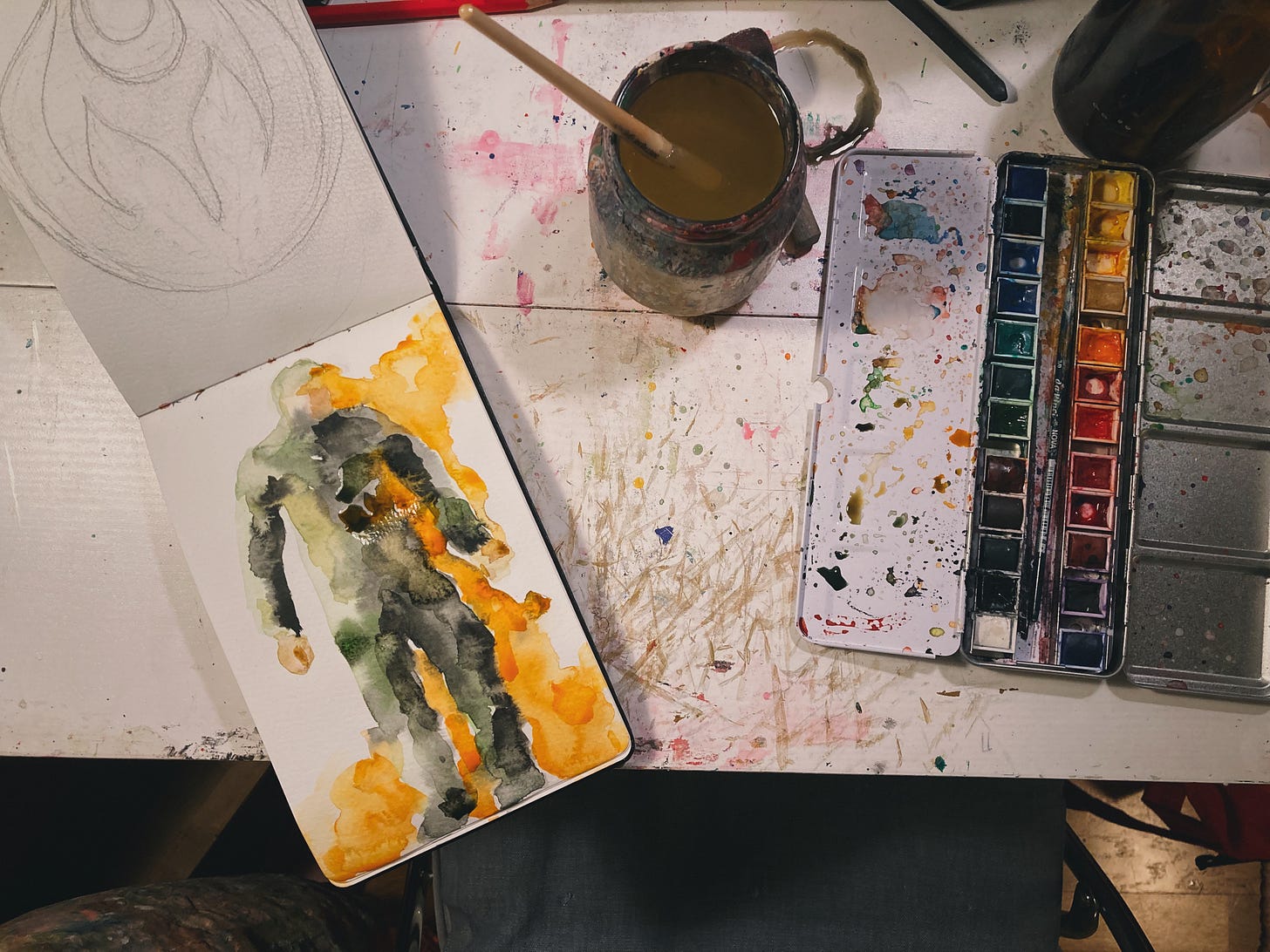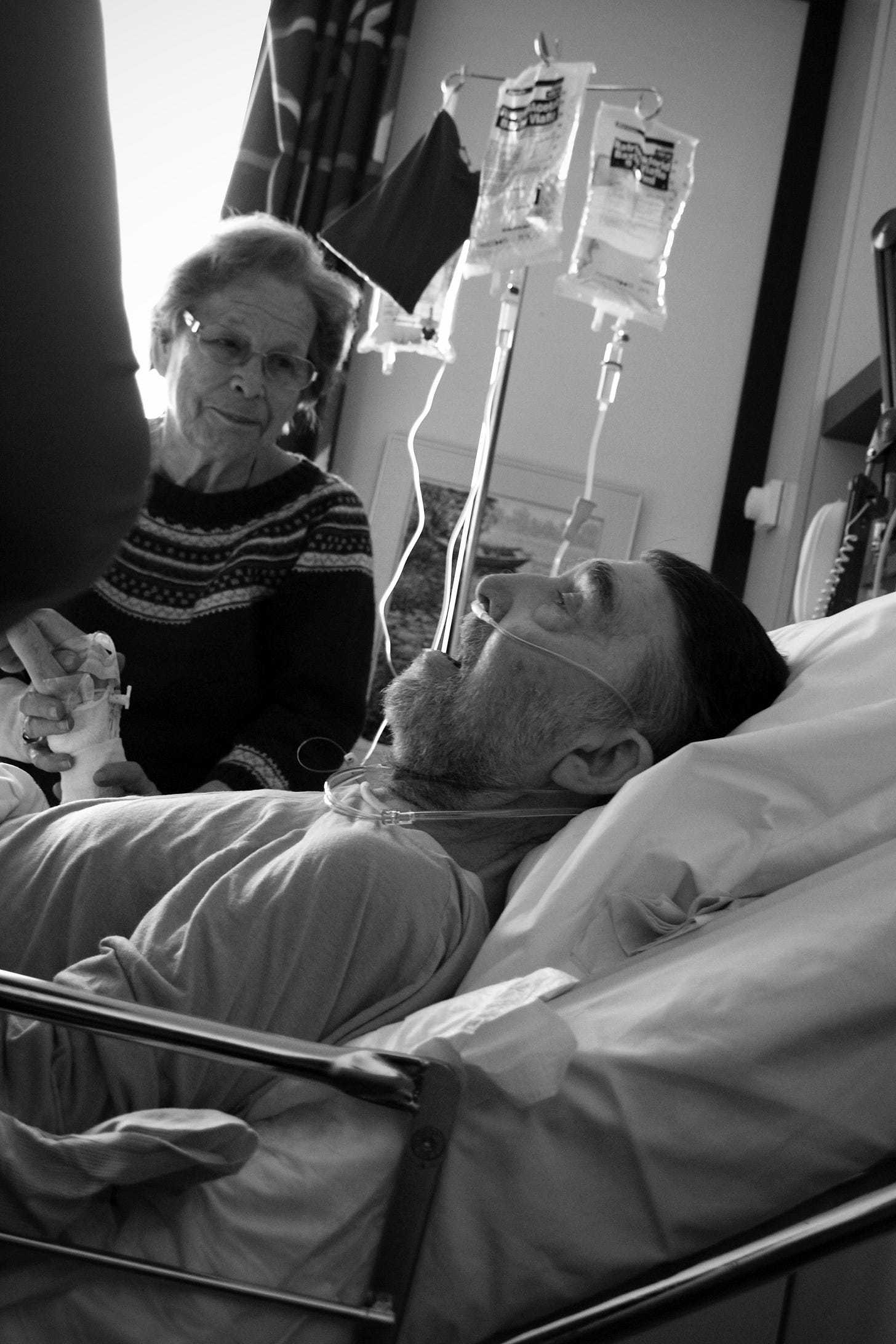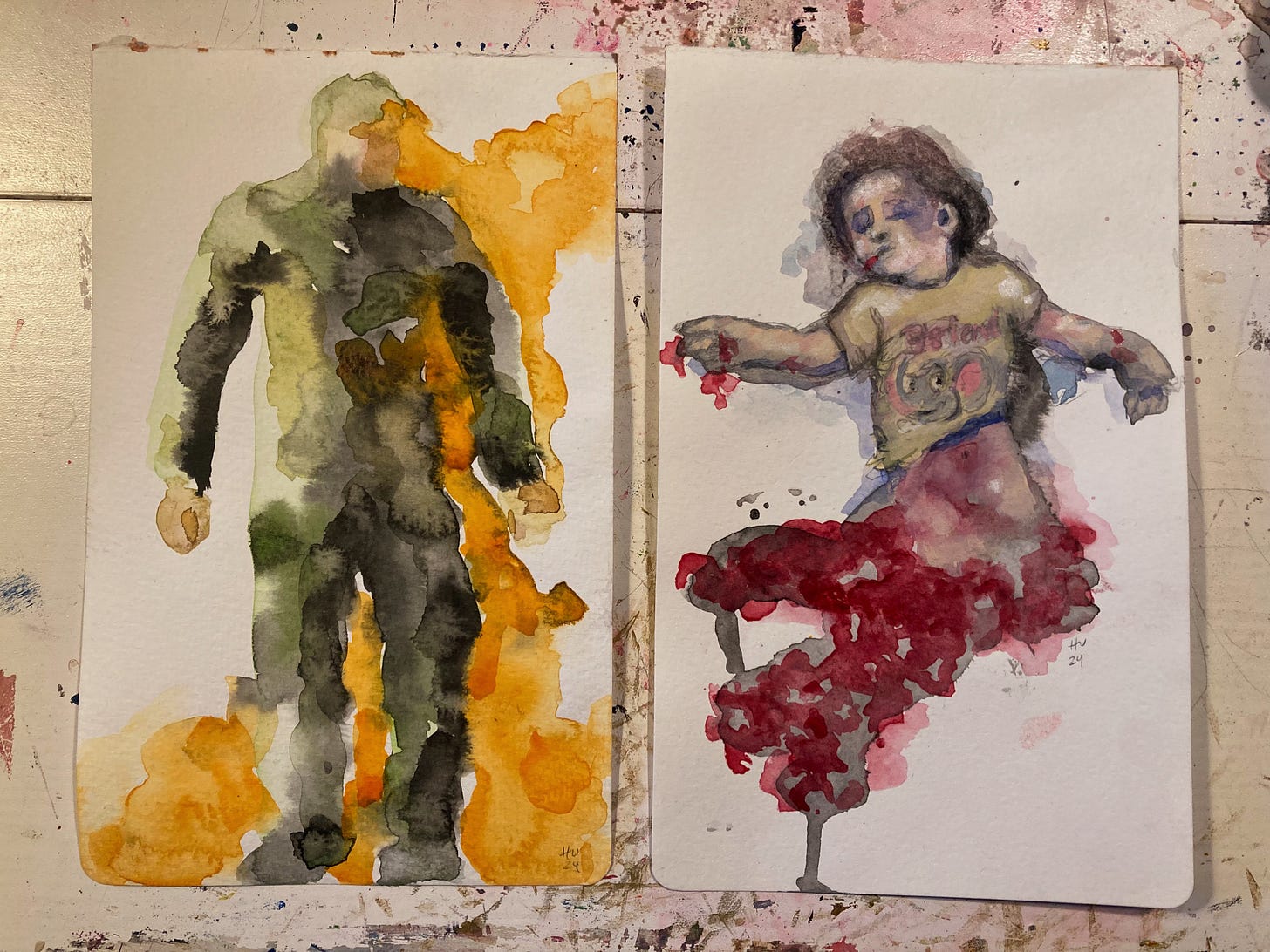
Some years ago, when I was writing my bachelor about how photography could be used as a therapeutic method, I remember reflecting on the impact a photo can have on changing public perception. Images that will never leave you. Like the girl running from napalm in Vietnam, or the man standing in front of a tank on Tiananmen Square.

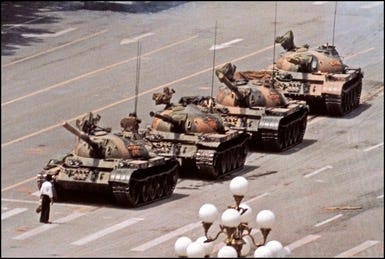
I can recall these images at any time, they’re a part of my internal gallery of images that I wouldn’t be able to forget even if I tried. They hold a type of power that is unexplainable to me. There are also photos of my own in this gallery. They would mean very little to others compared to the two above, but they matter a lot to me.
I’ve been working on a series of small watercolors lately. It began with the painting of Aaron Bushnell, who set himself on fire outside the front gates of the Israeli embassy in Washington DC in February of this year. The video of him, hearing him shout Free Palestine, until he could only scream in pain is one that will haunt me forever. And I thought, this is one of those images. This young man standing while burning to death, because he would no longer be complicit in any way to the ongoing genocide in Palestine. I saw the video, and the photos, but I didn’t want to see them, I didn’t want to understand it. I decided to confront that feeling, and paint him, in the hopes that this would be it, that it was going to stop now.
But it didn’t stop. It just continues to get worse. And so the other day, after seeing a little girl lying dead on the ground in a pool of her own blood with half her body missing, I continued the series, that I’m calling This Is What Our Ruling Class Has Decided Will Be Normal, after a quote by Aaron Bushnell. The series is based on photos and screenshots from videos of crimes against humanity, that we all have livestreamed on our phones.

I was thinking recently about the number of images we see now, compared to 1972 when the girl was photographed running, or 1989, when the man stood in front of a tank in defiance. I wondered if they made this huge impression on people, on me, because we saw far less images, compared to now, when we are saturated by images at all time. Now with AI, even more images are constantly generated, simply because we can, and this worries me a lot. So when I paint these horrible scenes, it is an act of defiance for me, and an attempt to give the victims back some of their dignity by spending time seeing them. I try to take them in as much as I can, without being consumed and paralyzed by the violence I’m seeing, and for that reason I use watercolors. The medium makes me work quickly, but it also forces me to slow down and sit completely still with the images. Watercolours are also less forgiving when it comes to painting over mistakes, so I have to focus a lot on what I’m doing, which creates enough emotional distance for me to be able to look for a long time at photos of some of the most horrific things I have ever seen.

I struggle with this work, because I want to treat people suffering with respect. I have the same issue whenever I photograph people who are going through something. I hesitate to take a photo of someone living on the streets for instance, because they don’t have the same choice as I do to keep what is private, private. The “best” photos of people, I never took, because I would have revealed something about them that I didn’t have their permission to do.
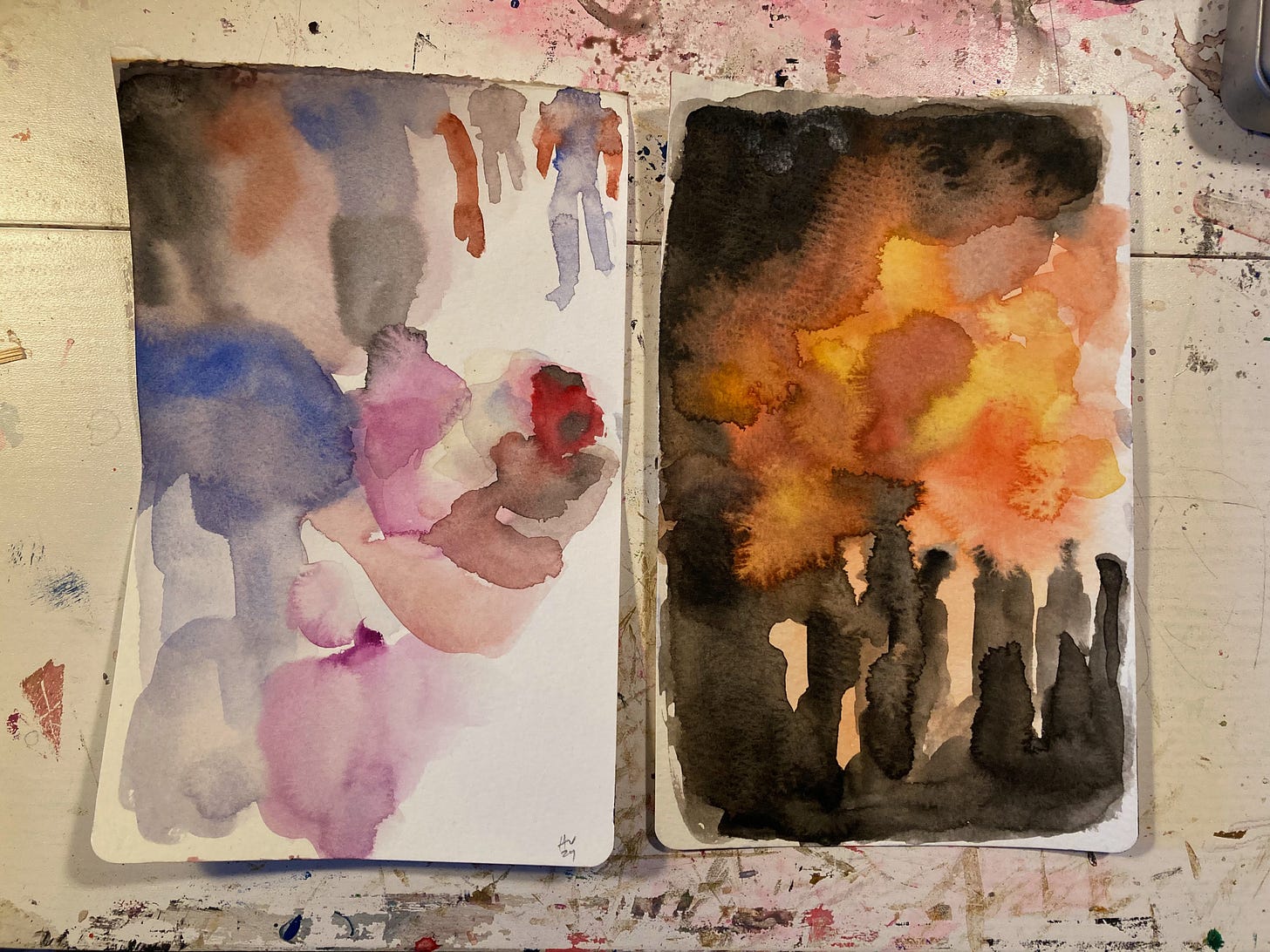
I watch all these people die surrounded by cameras. All the horrors, the grief, the despair, the absolute worst moments of their lives are being documented and shared all over the world in real time, because we are left with no other choice than to expose the reality of what is happening in a desperate attempt to stop it. I see fathers carrying their dead children being photographed while trying to keep themselves together, I see severely injured patients having to lie on a hospital floor in a pool of their own blood, with no comfort other than the touch of another human being trying to ease their pain with their presence because there are no more pain-medication available. And I am reminded, of the times I’ve sat next to loved ones who have been sick, or dying.
The photo above is of my grandparents in 2012, when my grandfather was sick and in the hospital, where he received care, got better, and went back home. I love my grandparents very much, they have since both passed, and on that day I was so scared and sad, that the only way for me to deal with being there, was to bring my camera. The camera allows me some distance, and I needed that to be able to cope. I was very worried that my grandmother wouldn’t approve of me taking photos, she’s always been the most important person in my life, but she just smiled and gave me a nod the way only she could to let me know that she understood. These photos always make me cry, because I miss them, but they are also some of the most precious photos I have.
Looking at the images from Palestine, registering the amount of them, it’s like we have become numb to the way the bodies of the injured men, women and children are being handled, because people seem to just carry on with our day after seeing them. When my grandfather was ill, he was lying in a comfortable and clean bed. He received care, both professionally and from us, his family who loved him. I imagine him instead lying alone on a floor in a pool of his own blood, and I can’t breathe.
I paint a young boy who is sitting on the hospital floor. He’s got a bandage around his head, and have received the best care that he could possibly get under these circumstances I’m sure, but he’s just a boy, sitting alone on the hospital floor. His face is covered in dried blood. And I want to scream, because where is his mum, his dad, where is his hospital bed, where are the soft pillows, his hospital gown? His t-shirt is soaked in blood and dirt, and he’s just sitting there, with an empty traumatized stare, and we let him.

I paint a father holding his little boy for the last time, and I remember a photo of my grandfather and his son, my father. I remember my grandfather’s simple and profound gesture of love and affection for his boy, who will always be his little boy no matter how old they both are, and I am so grateful that I caught with my camera.
This is not complicated.
Every human being deserves to live and die with dignity. Every human being deserves to be treated with love, care, and respect. I paint the victims of a world order that have betrayed our humanity, because I will not accept this. My family, my blood, is not more precious than the blood of the Palestinian people, and I refuse to settle for a system that makes you believe that yours are.
Yesterday, over 200 Palestinians were massacred to get 4 Israeli hostages out of Gaza. This is what our ruling class has decided will be normal, and an acceptable loss, with over 50 Palestinian lives in exchange for one Israeli life. The math is disgusting.
This is how deep rooted racism is in this oppressive system. The ruling class have no boundaries, no red lines that they are not willing to cross if it protects their position of power. We have seen with our own eyes the hypocrisy of our own governments, and the erosion of international ruled-based order. I am deeply concerned for us all, because we are in serious trouble, and I haven’t even mentioned the imminent ecological collapse that will make every humanitarian crisis worse than we can imagine.
The US is now so overtly involved in the genocide in Gaza, that come election between two presidential candidates that are both an insult to humanity, the biggest and most dangerous military power on earth will probably be even more isolated than ever, and thus an even bigger threat to the planet than I think any of us wants to consider. I’m really scared. I don’t want to write about stuff like this, or even think these things. I seriously just want to paint and grow a garden. Like, you have no idea how badly I just want to close my eyes to all of this. But we have to be the ones to draw a red line now, because the people in power have shown us that they won’t.
This is on us.

